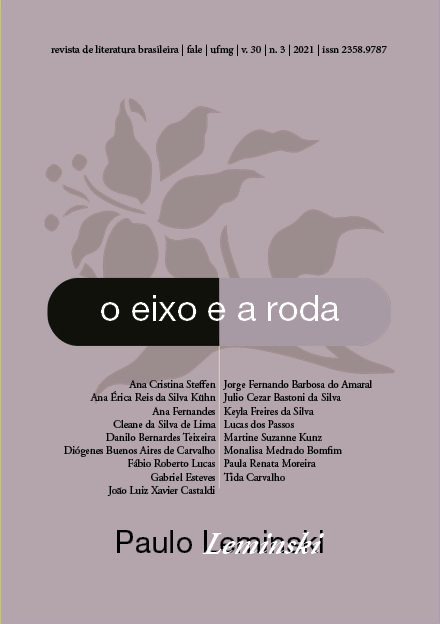Dissolute Cartesius
DOI:
https://doi.org/10.17851/2358-9787.30.3.59-80Keywords:
Paulo Leminski, Catatau, René Descartes, Brazilian literature, character study, philosophyAbstract
In Paulo Leminski’s novel, Catatau, a recognizable character is projected: Renatus Cartesius, the immense soliloquy’s producer that constitutes the entire text, seems to correspond to René Descartes, the famous 17th century French mathematician. Standing under a tree at the Recife Botanical Garden between the lenses of his bezel and the narcotic weed pipe he voraciously smokes, Cartesius makes contact with the wild Brazilian nature, although (Cartesian) organized in the form of a zoobotanical garden. This article intends to investigate at first the way in which Leminski’s novel-idea handles this inevitable contrast between both Descartes: Descartes from the History of Philosophy, author of Rules for the Direction of the Mind and the intemperate Cartesius from the fictional situation engendered by Leminski. To conduct such an investigation, this article sought to stick to some passages of the novel in order to check the ways in which Descartes’s parody and carnival figuration are based on an anticartesian dissolution of the character’s egoic integrity, thus generating much more than superficial humor. Rather, the article defends the hypothesis that with the dissolution of Descartes’s figure, the novel outlines an anthropophagic reaction to the colonial processes to which Brazil would have been exposed throughout its history. This counter-colonizing reaction is sustained insofar as it associates Cartesius’s egoic disintegration with the impact caused by an exuberant nature, which due to its hyperbolic constitution, does not submit to the quadratues imposed by the European thought – of which Descartes becomes an emblem.
Downloads
References
ABRÃO, Daniel. Poesia e pensamento no Catatau, de Paulo Leminski. 2007. Tese (Doutorado em Letras) – Instituto de Biociências e Letras, Universidade Estadual Paulista, 2007. Disponível em: https://repositorio. unesp.br/handle/11449/106327. Acesso em: 18 jul. 2018
ANDRADE, Oswald de. O manifesto antropófago. In: TELES, G. M. Vanguarda européia e modernismo brasileiro: apresentação e crítica dos principais manifestos vanguardistas. 3. ed. Petrópolis: Vozes; Brasília: INL, 1976.
ARRIGUCCI JR., Davi. O escorpião encalacrado: a poética da destruição em Julio Cortázar. São Paulo: Perspectiva, 1973.
BAKHTIN, Mikhail. A cultura popular na Idade Média e no Renascimento: O contexto de François Rabelais. 8. ed. Tradução de Yara Frateschi Vieira. São Paulo: Hucitec, 2013.
BONVINCINO, Régis. Com quantos paus de faz um catatau. In: LEMINSKI, P. Catatau. Porto Alegre: Sulina, 1989.
CAMPOS, Haroldo de. Uma leminskíada barrocodélica. In: FROES, Elson. Kamiquase. [S. l.: s. n.], 2021. Disponível em: http://www.elsonfroes.com. br/kamiquase/ensaio14.htm. Acesso em: 16 jul. 2018.
KASPCHAK, Carlão. Descartes maconheiro?: José Miguel Wisnik analisa Catatau e coloca Leminski entre os grandes. [S. l.: s. n.], 1999. Disponível em: http://www.leminski.hpg.ig.com.br/ensaio35.html Acesso em: 10 mar. 2002.
LEMINSKI, Paulo. Catatau. 3. ed. Curitiba: Travessa dos editores, 2004a.
LEMINSKI, Paulo. Descordenadas artesianas. In: LEMINISKI, P. Catatau. Curitiba: Travessa dos Editores, 2004b. Edição crítica e anotada, p. 250.
MERLEAU-PONTY, Maurice. Fenomenologia da Percepção. São Paulo: Martins Fontes, 1994.
PESSOA, Fernando. Obra completa de Alberto Caeiro. Edição de Jerónimo Pizarro e Patrício Ferrari. Rio de Janeiro: Tinta da China, 2018.
TEIXEIRA, Danilo Bernardes. Leitura e metaleitura do Catatau de Paulo Leminski. Tese (Doutorado em Teoria Literária) – Faculdade de Filosofia, Letras e Ciências Humanas, Universidade de São Paulo. São Paulo, 2018.




 Esta obra está licenciada com uma Licença
Esta obra está licenciada com uma Licença 